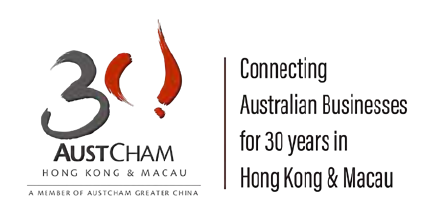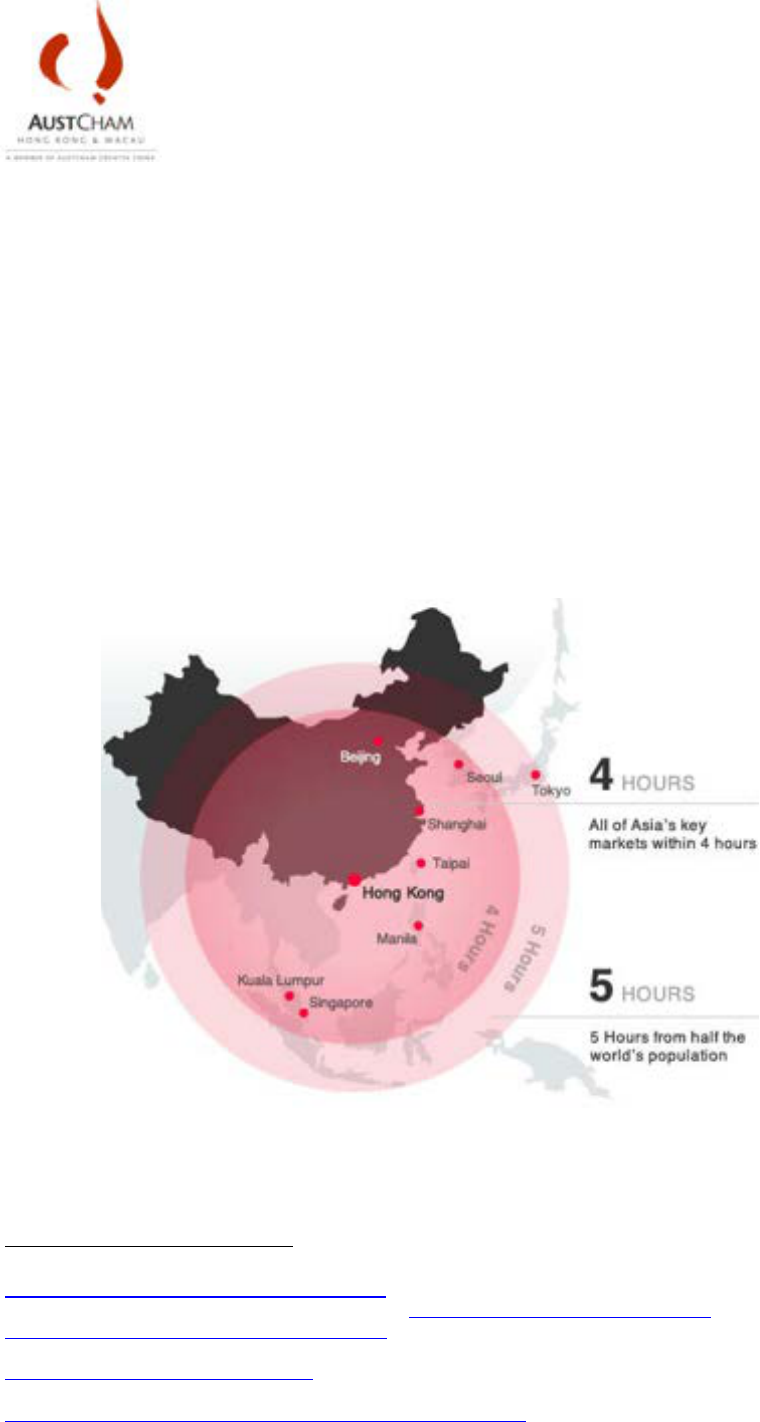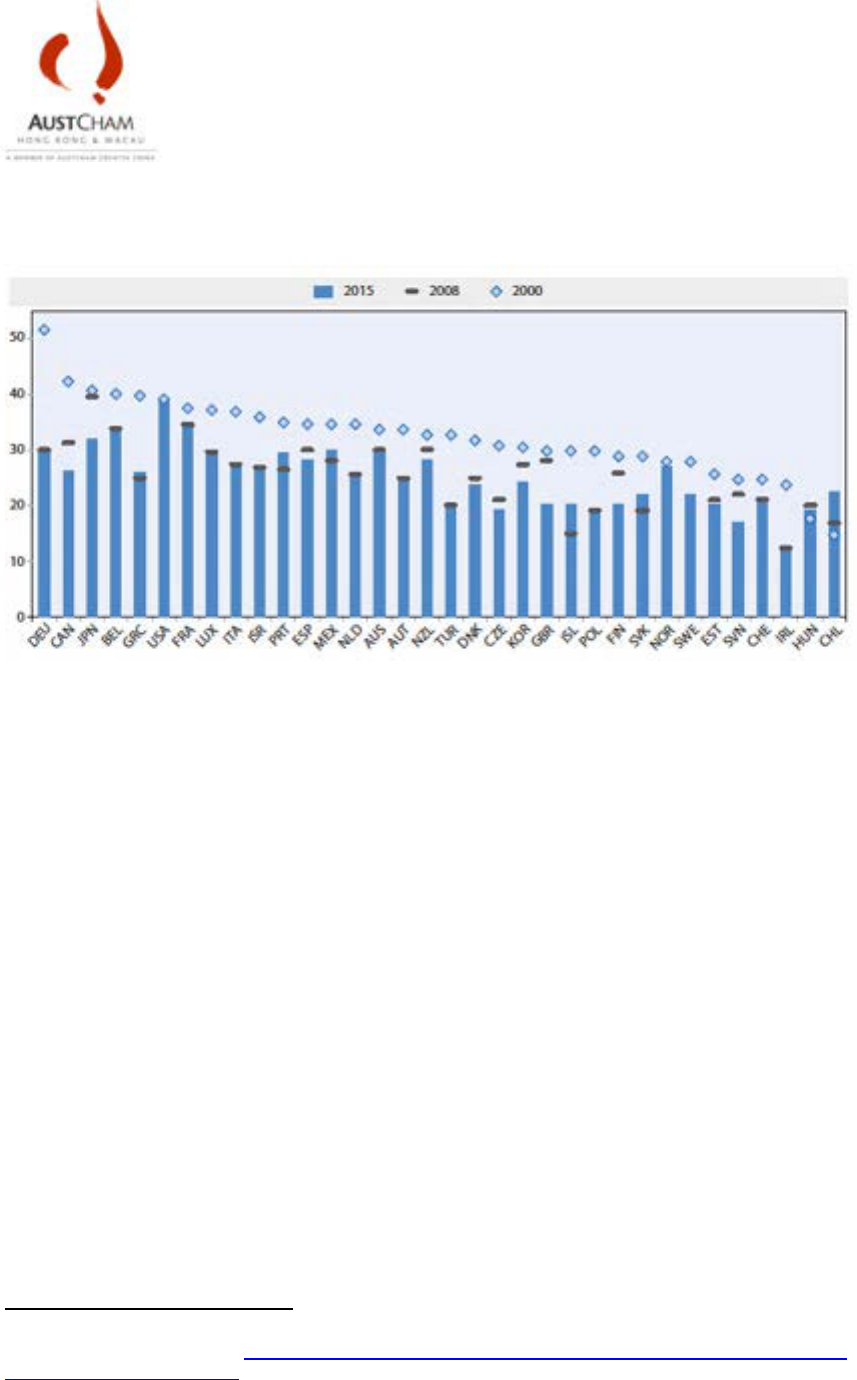
The Australian Chamber of Commerce in Hong Kong
Room 302, 3/F, Lucky Building, 39 Wellington Street, Central, Hong Kong
Tel: (852) 2522 5054 Fax: (852) 2877 0860
austcham@austcham.com.hk www.austcham.com.hk
Tax Treaties Branch
Corporate and International Tax Division
Treasury
Email: TaxTreatiesBranch@treasury.gov.au
15 April 2024
Dear Sir or Madam,
Submission on Australia’s Tax Treaty Network Expansion
The Australian Chamber of Commerce in Hong Kong (AustCham) represents more than 800 members
from 245+ companies. We are one of the largest international chambers in Hong Kong and one of the
largest Australian chambers abroad. AustCham’s membership includes Australian businesses
operating offshore, Hong Kong companies with significant investments in Australia, international
companies with operations in Australia and Hong Kong, and individuals leading Small and Medium
Sized businesses and working for global business in Hong Kong. AustCham has been in Hong Kong
since 1987 supporting our members, their business and the Australia-Hong Kong bi-lateral
relationship.
The Treasury’s consultation seeking views on issues related to Australia’s tax treaty network provides
an opportunity to once again share AustCham’s support for expanding Australia’s tax treaty network
by considering a comprehensive Double Tax Agreement (DTA) between Australia and Hong Kong.
Hong Kong is home to over 100,000 Australian nationals, with the largest number of Australian
businesses based outside Australia and our second largest expatriate community globally. As of 2023,
there were 27 regional headquarters, 52 regional offices and 80 local offices in Hong Kong with parent
companies located in Australia – the 10th largest international representation of international regional
headquarters in Hong Kong.
Hong Kong is a global financial centre and Asia’s leading finance hub. It is a major logistics and
transportation hub and remains the gateway to and from China and the wider North Asia region
(including Japan, Korea and Taiwan) for investment and capital flows. North Asia accounts for the
largest proportion of Asian trade with the rest of the world. Hong Kong is a key trade partner to
Australia and is the country’s 11
th
largest source of direct foreign investment. A DTA with Hong Kong
will allow alignment and consistency with how Australia treats its major trading and investment
partners.
Hong Kong has 48 DTAs in place with jurisdictions that include Australian tax treaty partners such as
the United Kingdom, Singapore, New Zealand, Japan, Indonesia and Malaysia. As an example, Hong
Kong and New Zealand signed a tax treaty in December 2010, which entered into force in November
2011. Hong Kong is also currently in DTA negotiations with 17 other jurisdictions, including Germany,
Israel and Norway. We understand the Hong Kong government is very receptive to entering into DTA
negotiations with Australia.
A DTA between Australia and Hong Kong is critical for Australian business and important in
strengthening the relationship between Australia and Hong Kong. Such an agreement fosters
increased cross-border trade and investment between the two jurisdictions and secure economic
growth into the future, whilst demonstrating a shared commitment to addressing international tax
avoidance practices.

The Australian Chamber of Commerce in Hong Kong
Room 302, 3/F, Lucky Building, 39 Wellington Street, Central, Hong Kong
Tel: (852) 2522 5054 Fax: (852) 2877 0860
austcham@austcham.com.hk www.austcham.com.hk
In 2017 AustCham provided a detailed submission (enclosed) on the benefits of an Australia-Hong
Kong Double Taxation Agreement. The issues discussed in this submission remain significant and
relevant today. There are real and tangible advantages to Australia in terms of greater information and
transparency in entering into a DTA with Hong Kong, including:
• providing complementarity and support to the Australia-Hong Kong Free Trade Agreement
• strengthening investment into Australia, particularly given large infrastructure projects
requiring capital such as green energy and decarbonisation projects
• providing greater access to information in Hong Kong for the ATO
• protecting Australian tax residents temporarily based in Hong Kong, from Australian tax on
their foreign source income (assuming they are allocated to Hong Kong under the tie-breaker
provisions)
• Increasing the attractiveness of Australia for leading global talent, especially international
executives, identified as a solution to addressing Australia’s skills deficit and accelerating
economic growth.
These last two points are particularly critical given the proposed reform of Australia’s individual tax
residency tests and proposed adoption of the Board of Taxation’s recommendations in its 2019 report
1
.
AustCham has actively engaged with Treasury on the proposed recommendations, and I enclose a copy
of our submission to the Australian Government Consultation on Modernising the Individual Tax
Residency Rules (dated 22 September 2023).
Recent developments with the implementation of the OECD/G20 Base Erosion and Profit Shifting
(BEPS) Inclusive Framework also underscore the need for greater certainty a DTA can provide for
Australian businesses in Hong Kong.
If you have any queries about this submission, contact myself on austcham@austcham.com.hk or by
phone +852 6398 6105.
Yours sincerely,
Stefanie Evennett
Chief Executive
Encl.: March 2017, AustCham Hong Kong Submission, Australia - Hong Kong Comprehensive Double Taxation Agreement: Securing
economic growth into the future (Confidential)
September 2023, AustCham Hong Kong Submission to Australian Government Consultation on Modernising the Individual Tax Residency
Rules
CC Gareth Williams, Australian Consul-General in Hong Kong
1
The previous Federal Government in the 2021/2022 Federal Budget proposed to consider the recommendations of the Board of Taxation in
reforming Australia’s tax residency rules as contained in its report released in 2019 ‘Reforming Individual Tax Residency Rules – a
model for modernisation’.

The Australian Chamber of Commerce in Hong Kong
Room 302, 3/F, Lucky Building, 39 Wellington Street, Central, Hong Kong
Tel: (852) 2522 5054 Fax: (852) 2877 0860
austcham@austcham.com.hk www.austcham.com.hk

Australia - Hong Kong
Comprehensive Double
Taxation Agreement
Securing economic growth into the future
AustCham Hong Kong
March 2017
Contact: Darren Bowdern
AustCham Board of Directors (Treasurer)
& Co-Chair of the Finance, Legal and Tax (FTL) Committee
/ Partner, KPMG in Hong Kong
T: +85 2 2826 7166
E: darren.bowdern@kpmg.com
Document classification: Highly Confidential

Australia - Hong Kong Comprehensive Double Taxation Agreement
March 2017
i
Document classification: Highly Confidential
Contents
1 Executive summary 1
2 Background 3
2.1 The challenge of economic growth 3
2.2 The BEPS challenge 3
2.3 Hong Kong’s commitment to expanding its DTA network 4
3 Treaty benefits 6
3.1 Enhance cross-border trade and investment between Australia
and Hong Kong 6
3.2 Gateway to Asian markets 8
3.3 Australia as a major financial centre in Asia 9
3.4 Co-operation on international tax integrity 9
4 Comparison: Singapore DTA 11
5 Perceived loss of revenue 12
6 A more internationally competitive Australia 14
7 The way forward 17
A Hong Kong’s DTA network 18
B Australia’s DTA network 19

Australia - Hong Kong Comprehensive Double Taxation Agreement
March 2017
1
Document classification: Highly Confidential
1 Executive summary
Political uncertainties in many parts of the world are impacting the global economic
outlook. At the same time, Governments around the world are also faced with the
challenge of globalisation, which is exacerbating opportunities for tax avoidance.
The idea of a double taxation agreement (“DTA”) between Australia and Hong Kong is
not new, and now is the time for action. This is the time for Australia and Hong Kong to
enter into a DTA to foster increased cross-border trade and investment in the region and
secure economic growth into the future, whilst demonstrating Australia’s and Hong
Kong's commitment to addressing international tax avoidance practices.
Hong Kong is one of Australia’s top 15 partners in terms of trade in goods and services
1
.
Hong Kong is also the 6
th
highest source of investment in Australia; this is followed by
China at the 7
th
position, which also makes a large proportion of its outbound investments
through Hong Kong
2
. Although Australia has an established network of DTAs with its
main trading and investment partners such as China (the DTA does not extend to cover
Hong Kong) and Singapore (which has a similar tax system to Hong Kong), Hong Kong
is a notable absence from Australia’s DTA network.
A DTA between Australia and Hong Kong would provide benefits to both signatories.
Hong Kong has a longstanding economic policy of free enterprise and free trade, and is
strategically located in the heart of Asia and a key financial center in the region.
Geographically and commercially, Hong Kong is an attractive entry point for other
countries looking to do business in the region; in particular, Hong Kong is proven
gateway to China’s high growth markets (which we understand is increasingly important
for Australia).
A DTA between Australia and Hong Kong would foster increased cross-border trade and
investment between the two jurisdictions as well as enhanced access to other parts of
Asia for Australian businesses. Specifically, with regard to Australia’s aspirations to
deliver new sources of growth through innovation
3
, a DTA between Australia and Hong
Kong would support Australian businesses that are seeking to commercialise good ideas
with realising the potential of Asian markets, and in turn, Australia’s shift from the mining
boom to the “ideas booms”. The DTA would provide greater certainty and simplicity for
businesses operating in the region with respect to the taxation of cross-border
investment and transfer of human capital (which is particularly relevant for businesses
built on innovation).
In line with international efforts, the DTA can also be used by Australia and Hong Kong
to jointly respond to the challenge of effective tax administration in today’s global
environment through anti-treaty abuse safeguards, mutual assistance in tax collection,
exchange of tax information and improved dispute resolution, which are common
features in modern DTAs.
1
Australian Government Department of Foreign Affairs and Trade (“DFAT”), Australia’s trade in goods and
services by top 15 partners, 2015-16, http://dfat.gov.au/about-us/publications/trade-investment/australias-
trade-in-goods-and-services/Pages/australias-trade-in-goods-and-services-2015-16.aspx#partners
2
Australian Government DFAT, Which countries invest in Australia?, 2015,
http://dfat.gov.au/trade/topics/investment/Pages/which-countries-invest-in-australia.aspx
3
Australian Government, National Innovation and Science Agenda: Welcome to the Ideas Boom, 7
December 2015, http://www.innovation.gov.au/page/national-innovation-and-science-agenda-report

Australia - Hong Kong Comprehensive Double Taxation Agreement
March 2017
2
Document classification: Highly Confidential
We understand that there have been a number of discussions between the Hong Kong
Financial Services and Treasury Bureau, and the Australian Treasury in the past to
discuss a DTA. The Australian Treasury is, as we understand it, receptive to the idea of
a DTA, subject to an evaluation of the implications of concluding a DTA with Hong Kong.
Specifically, we understand that Australia’s primary concern has related to a potential
loss of revenue as result of entering into a DTA. We note that there should be little impact,
if any, on revenue collection for dividend and interest withholding tax; the only potential
impact is in respect of royalty withholding tax if the DTA were to provide for reduced
royalty withholding tax on royalties paid from Australia to Hong Kong. Given that Hong
Kong has re-affirmed its commitment to expanding its DTA networks
4
, and has
demonstrated willingness to be flexible in treaty negotiations in the past, a DTA between
Australia and Hong Kong could presumably involve a carve-out in respect of the royalty
article, if this is considered necessary.
In any event, it is unlikely that the Australian Taxation Office (“ATO”) would collect any
meaningful amounts of royalty withholding tax on payments to Hong Kong. For Australian
businesses selling technology intensive goods and services into Asian markets, it is more
likely that there would be royalties paid to Australia for the use of intellectual property
developed and located in Australia.
Tax as a “growth friendly” strategy and strengthening cooperation to close the gaps in
international tax rules have never been higher on the agenda for world leaders. By
entering into a DTA with Hong Kong, Australia would be sending the message that it is
looking ahead and committed to supporting the Australian economy’s shift to broader-
based growth by making the most of opportunities offered in Hong Kong and other parts
of the region. This is the time for Australia and Hong Kong to partner up to secure
economic growth into the future.
4
Hong Kong Financial Secretary’s 2017/18 Budget Speech, released on 22 February 2017

Australia - Hong Kong Comprehensive Double Taxation Agreement
March 2017
3
Document classification: Highly Confidential
2 Background
2.1 The challenge of economic growth
The World Bank is projecting a growth of 2.7 percent in 2017 for the global economy
after a post-crisis low last year
5
. The shifting political landscape in many parts of the
world – for example, the United Kingdom’s (“UK”) decision to leave the European Union
(“Brexit”), the United States (“US”) Presidential Election in 2016 and political uncertainty
ahead of crucial elections in the eurozone
6
– is impacting the global economic outlook.
A need for action to manage the associated uncertainties is high on the agenda for world
leaders.
In Australia, the economy continues to transition from the investment phase to the
production phase of the mining boom and the challenge is achieving broader-based
growth.
7
As the International Monetary Fund (“IMF”) noted in its annual assessment of
the Australian economy, although economic growth in Australia has been relatively
robust despite the unwinding of the mining boom, “Australia has not been immune to the
new mediocre”
8
. We understand that the Australian Federal Government is focused on
securing Australia’s economic growth in light of the significant risks and uncertainties
ahead such as weaker than expected domestic consumption and rise of protectionist
measures in G20 economies
9
. Indeed, the IMF has endorsed the Australian
Government’s reform agenda given the focus on strengthening competition and fostering
innovation, and Australia’s commitment to “an open economy in trade, foreign investment
and immigration”
10
.
2.2 The BEPS challenge
At the same time, there have been significant changes in the international tax landscape
in recent years to address the risk of tax base erosion and profit shifting by multinationals.
In the aftermath of the global financial crisis, the G20 and OECD have partnered to
establish a modern international tax framework that is focused on:
— Ensuring that profits are taxed where the value is created; and
— Tax transparency as a means of enabling improved accountability and cooperation
between taxpayers and tax administrations.
5
World Bank Group Flagship Report, Global Economic Prospects: Weak Investment in Uncertain Times,
January 2017, https://openknowledge.worldbank.org/bitstream/handle/10986/25823/9781464810169.pdf
6
The Netherland’s General Election was held on 15 March 2017 and is the first in series of elections
across Europe this year, which includes France’s Presidential Election (first round on 23 April 2017,
second round on 7 May 2017) and Germany’s Federal Election on 22 October 2017
7
The Australian Federal Government’s Mid-Year Economic and Fiscal Outlook 2016-17, December 2016,
http://www.budget.gov.au/2016-17/content/myefo/html/
8
International Monetary Fund (“IMF”), IMF Executive Board Concludes 2016 Article IV Consultation with
Australia, 9 February 2017, https://www.imf.org/en/News/Articles/2017/02/09/PR1741-Australia-IMF-
Executive-Board-Concludes-2016-Article-IV-Consultation
9
OECD/ World Trade Organisation (“WTO”)/ United Nations Conference on Trade and Development
(“UNCTAD”), Reports on G20 Trade and Investment Measures (Mid May to Mid-October 2016), 10
November 2016, https://www.wto.org/english/news_e/news16_e/g20_joint_summary_november16_e.pdf
10
Refer Note 7

Australia - Hong Kong Comprehensive Double Taxation Agreement
March 2017
4
Document classification: Highly Confidential
Since the G20/OECD first embarked on this project (referred to as the Base Erosion and
Profit Shifting (“BEPS”) Project), more than 60 jurisdictions have been involved in
delivering the 15 Action Plans under the BEPS Project (released in November 2015)
11
.
There are now more than 90 jurisdictions (including Australia and Hong Kong) who are
working together to set standards for the implementation of the BEPS Action Plans in
their domestic tax laws
12
. Specifically, these jurisdictions have committed to four
minimum standards:
— Countering harmful tax practices more effectively;
— Preventing treaty abuse;
— Imposing country-by-country reporting requirements; and
— Improving the cross-border dispute resolution regime
13
.
For instance, as part of its commitment to implement a model that meets international
standards, Hong Kong has recently announced the introduction of specific transfer
pricing rules that are aimed at ensuring that taxpayers earn an arm’s length profit for the
activities they are performing, and which include mandatory transfer pricing
documentation requirements
14
.
In connection with the BEPS Project, Australia and Hong Kong, together with more than
other 100 jurisdictions, have also participated in developing the Multilateral Convention
to Implement Tax Treaty Related Measures to Prevent Base Erosion and Profit Shifting
(“the Multilateral Instrument”) (released on 31 December 2016 with signature by the
relevant countries planned for June 2017)
15
. The Multilateral Instrument implements
standards for countering treaty abuse, improve dispute resolution mechanisms and
strengthen the tax treaty related measures developed under the BEPS Project.
2.3 Hong Kong’s commitment to expanding its DTA network
Hong Kong is the leading financial services centre in Asia, as well as the preferred
regional or head office jurisdiction for many multinational and Asian corporations. Hong
Kong is looking to further capitalise on its status as a head office and financial services
centre, and to promote cross-border trade and investment between China and the rest
of the world. Hong Kong’s proximity to China and other parts of Asia, and its international
business environment, makes it a preferred jurisdiction for investors to establish
business operations and to hold their investments in Asia. In support of this, Hong Kong
has been actively seeking to expand its DTA network. DTAs have already been signed
with China, the UK, France, Switzerland, Malaysia and Indonesia (37 jurisdictions in total
11
OECD/G20 Base Erosion and Profit Shifting Project, 2015 Final Reports, http://www.oecd.org/ctp/beps-
2015-final-reports.htm
12
OECD Inclusive Framework on BEPS Composition as at 5 January 2017,
https://www.oecd.org/tax/beps/inclusive-framework-on-beps-composition.pdf
13
OECD, BEPS: About BEPS and the inclusive framework, http://www.oecd.org/tax/beps/beps-about.htm
14
On 26 October 2016, the Hong Kong Government issued a consultation paper on a range of measures
including a proposal to introduce specific transfer pricing rules for Hong Kong. Draft legislation is expected
to be introduced by mid-2017
15
OECD’s Information Brochure on the Multilateral Convention to Implement Tax Treaty Related
Measures to Prevent Base Erosion and Profit Shifting, http://www.oecd.org/tax/treaties/multilateral-
instrument-BEPS-tax-treaty-information-brochure.pdf

Australia - Hong Kong Comprehensive Double Taxation Agreement
March 2017
5
Document classification: Highly Confidential
as of 28 February 2017).
16
Hong Kong has also signed a DTA with New Zealand and
Canada, and is currently negotiating a DTA with Germany, jurisdictions with similar
taxation regimes to that of Australia.
More recently, Hong Kong has signed DTAs with Russia (18 January 2016), Latvia (13
April 2016) and Belarus (16 January 2017) and Pakistan (17 February 2017), major
developing economies along the “One Belt One Road”. Hong Kong is continuing its
efforts to expand its network of DTAs with other trading and investment partners. In
addition to current negotiations with Australia, Hong Kong is also in negotiations with a
further 14 jurisdictions (including India and Germany).
16
Refer Appendix A: Hong Kong’s DTA network

Australia - Hong Kong Comprehensive Double Taxation Agreement
March 2017
6
Document classification: Highly Confidential
3 Treaty benefits
Australia is currently a party to 44 DTAs (as at 28 February 2017), including the revised
DTA with Germany that was signed on 12 November 2015.
17
While Australia has treaties
with many trading partners (including some neighbouring Asian jurisdictions), most of
them are relatively old and the existing DTA between Australia and China does not
extend to cover Hong Kong.
There is an opportunity here for Australia and Hong Kong to enter into a DTA to minimise
barriers to key drivers of economic growth such as investment, innovation and
entrepreneurship. A DTA between Australia and Hong Kong helps ensure that Australia
is in a competitive position for trade and investment with Hong Kong as well as other
parts of Asia, which would provide benefits to both jurisdictions. The mutual benefit of
increased cross-border trade and investment supports innovation, job creation and future
economic growth for Australia and Hong Kong.
3.1 Enhance cross-border trade and investment between Australia
and Hong Kong
Australia and Hong Kong have a longstanding and significant trading relationship. Hong
Kong is Australia’s 12
th
largest two-way trading partner (2015-16)
18
, including being
Australia’s 6
th
largest destination for merchandise exports (A$8.8 billion) and 7
th
largest
destination for service exports (A$2.3 billion)
19
.
Hong Kong is also the 6
th
largest source of foreign investment for Australia (A$85.4 billion
in 2015). This outranks direct investment from China into Australia (A$74.5 billion in
2015)
20
, noting that many Chinese enterprises prefer to manage their outbound
investments through Hong Kong. Hong Kong’s investment in Australia ranges from
infrastructure and telecommunications to banking, property development, transport,
hospitality and agriculture
21
.
Importantly, there is room for growth. Based on Australia’s International Business Survey
2016 (“AIBS 2016”), which captures responses from more than 900 Australian
businesses undertaking international activities, Hong Kong is expected to be a key new
market for the “Information, Communications and Technology” (“ICT”) (ranked 7th) and
“professional, scientific and technical services” (ranked 8th) sector, in terms of additional
revenue expected over the next two years. This suggests that Australian business are
seeing opportunities for increased technology intensive goods and service exports to
Hong Kong. This is also consistent with a recent report on “Australia
’
s jobs future: The
rise of Asia and the services opportunity”
22
, which noted that service exports from
Australia to Asia are underperforming relative to Australia’s traditional partners and
17
Refer Appendix B: Australia’s DTA network
18
Refer Note 1
19
Australian Government Department of Foreign Affairs and Trade (“DFAT”), Trade and economic
factsheet for Hong Kong, December 2016, http://dfat.gov.au/trade/resources/Documents/hong.pdf
20
Refer Note 2
21
Hong Kong Financial Secretary, Australian Consulate-General Australia Day Reception Address on 24
January 2017, http://www.news.gov.hk/en/record/html/2017/01/20170124_204510.shtml
22
ANZ/ PwC/ Asialink Business Services Report, Australia’s jobs future: the rise of Asia and the services
opportunity”, April 2015, https://www.pwc.com.au/asia-practice/assets/anz-pwc-asialink-apr15.pdf

Australia - Hong Kong Comprehensive Double Taxation Agreement
March 2017
7
Document classification: Highly Confidential
concluded that by employing the right strategies, services can become Australia’s
number one export to Asia in terms of total value added, creating jobs in the process
23
.
At the same time, innovation and technology development is high on the Hong Kong
Government’s policy agenda, and Hong Kong’s Financial Secretary has expressed a
desire to partner with Australia in this area
24
.
Against this backdrop, a DTA between Australia and Hong Kong would foster bilateral
economic activity, and in particular, the commercialisation of technology intensive goods
and services in Asia by Australian businesses.
Based on a study conducted by the Australian Government’s Productivity Commission,
one of the barriers to growth in Australian service exports relates to investment in
Australian service providers
25
. Australia has always relied on foreign investment to drive
economic growth (and with it, growth in employment)
26
. However, tax laws in Australia
are often seen as very complex and can change suddenly. As tax certainty and simplicity
are some of the factors to consider in deciding whether to invest in Australia or
elsewhere, a DTA between Australia and Hong Kong would support increased
investment from Hong Kong into Australia by specifying the maximum rates of
withholding taxes that can be applied to dividends, interest and/or royalties. This allows
investors to make investment decisions with greater confidence and reduces compliance
costs for investors by making it easier to determine potential returns on investments.
Barriers to attracting skilled employees and impediments to the movement of services
have also been identified in the Productivity Commission’s study as barriers to growth in
Australian service exports. These could have a substantial effect on the supply of service
exports by increasing the ongoing costs of export operations and/or limiting the supply
of exports
27
. The services sector is particularly reliant on the availability of skilled
employees and in the case of service exports, entails a greater degree of cross-border
movement of employees than the export of goods. A DTA between Australia and Hong
Kong would reduce potential impediments in these areas by supporting the movement
of employees between these jurisdictions. For employees engaged in certain short-term
income-earning activities in Hong Kong, it could reduce compliance costs and provide
cash flow advantages by eliminating the need to pay tax in that jurisdiction (i.e. Hong
Kong) and then claim that tax against the tax liability in their home jurisdiction (i.e.
Australia). It would also support Australian businesses with the exchange of ideas for
innovation, developing an “Asia capable” workforce and competing on an international
level by leveraging from the experience of those in Hong Kong.
23
Commissioned by the Export Council of Australia (“ECA”) with the support of Austrade and Export
Finance and Insurance Corporation (“Efic”), http://www.austrade.gov.au/ArticleDocuments/1358/AIBS-
2016-full-report.pdf.aspx
24
Refer Note 20
25
Australian Government, Productivity Commission Research Report on Barriers to Growth in Service
Export, November 2015,
http://www.pc.gov.au/inquiries/completed/service-exports/report/service-
exports.pdf
26
Australian Government DFAT, Australia and Foreign Investment,
http://dfat.gov.au/trade/topics/investment/Pages/frequently-asked-questions.aspx
27
Refer Note 24

Australia - Hong Kong Comprehensive Double Taxation Agreement
March 2017
8
Document classification: Highly Confidential
3.2 Gateway to Asian markets
For Australian businesses looking to do business in Asia, Hong Kong is an attractive
entry point. Hong Kong is the top ranking jurisdiction on the Heritage Foundation’s Index
of Economic Freedom, which takes into account 12 quantitative and qualitative factors
(including government integrity, fiscal health, business freedom, trade freedom and
investment freedom), and has held this position for the last 22 years
28
. Hong Kong also
ranks 4th out of 190 economies on the World Bank’s “ease of doing business” rankings
29
.
Geographically, Hong Kong is located at the heart of Asia. Key Asian cities such as
Beijing, Shanghai, Singapore, Taipei, Manila and Kuala Lumpur are in the same time
zone as Hong Kong; Bangkok, Jakarta, Seoul and Tokyo are all within an hour’s
difference. Hong Kong’s success as a gateway to other Asian markets is underpinned
by peerless transport connections in the region. All of Asia’s key markets are less than
four hours’ flight time from Hong Kong; half of the world’s population is within five hours’
flight time from Hong Kong
30
.
Figure 3.1 Hong Kong’s strategic location
31
28
Heritage Foundation, 2017 Index of Economic Freedom,
http://www.heritage.org/index/country/hongkong;
The Government of the Hong Kong Special
Administrative Region InvestHK, Why Hong Kong, http://www.investhk.gov.hk/why-hong-
kong/international-transparent-and-efficient.html (last modified on 25 October 2016)
29
The World Bank, “Ease of Doing Business” Economy Rankings (2017),
http://www.doingbusiness.org/rankings
30
The Government of the Hong Kong Special Administrative Region InvestHK, Why Hong Kong,
http://www.investhk.gov.hk/why-hong-kong/strategic-location.html
(last modified on 25 October 2016)
31
Source: refer Note 29

Australia - Hong Kong Comprehensive Double Taxation Agreement
March 2017
9
Document classification: Highly Confidential
In particular, Hong Kong is a proven gateway into the Chinese high growth market and
has been used as an entry point by Australian exporters seeking to enter the Chinese
market. China remains a mainstay in supporting the global economic growth. The World
Bank is projecting a growth of 6.5 percent in 2017 for China and a medium-high growth
looking further ahead
32
. The growth in China and other parts of Asia represents an
opportunity for Australian businesses looking to increase market share (in particular,
through increased service exports to the region). Australian companies looking to do
business in Asia would benefit from the conclusion of a DTA between Australia and Hong
Kong. By fostering increased trade and investment between Australia and Hong Kong,
a DTA between the two jurisdictions is also supporting enhanced access to Asian
markets (through Hong Kong) for Australian businesses.
3.3 Australia as a major financial centre in Asia
We understand that Australia is seeking to establish closer economic ties with Asia and
to further its status as a major financial centre in the region. In this area, Hong Kong is
widely seen as one of the leading international and regional financial centres in Asia, and
the head or regional office location to some of Asia's largest corporate groups and many
multinational corporations.
By entering into a DTA with Hong Kong, Australia would be taking a step towards
fostering closer economic ties with Asia because of the role that Hong Kong has in
international financial and capital markets, and achieving improved interoperability
between Australia and Hong Kong as two of the key financial centres in the region.
Australia and Hong Kong have already sought to foster closer collaboration on renminbi
(“RMB”) trade settlement, the development of RMB-denominated products and closer
RMB banking and financial links, with regard to the increasing importance of the RMB
as a trade and investment currency in the region. Hong Kong was the first offshore
market to launch the RMB business in 2004, and remains the largest offshore RMB
hub
33
. In 2012, Australia and Hong Kong established a high-level dialogue between
respective senior business leaders to identify new opportunities arising from RMB use in
trade and investment in the region. The first Australia-Hong Kong RMB Trade and
Investment Dialogue was held in Sydney (April 2013); the second in Hong Kong (May
2014); and the third was again held in Sydney (July 2015). Based on SWIFT’s latest
RMB tracker (February 2017), Australia currently ranks as the 8
th
largest offshore RMB
clearing centre
34
.
3.4 Co-operation on international tax integrity
An important feature of the Hong Kong DTA is the inclusion of a standard OECD
information exchange article, which will give Australia the ability to request and exchange
32
Refer Note 5
33
Hong Kong Monetary Authority (“HKMA”), Hong Kong: The Global Offshore Renminbi Business Hub,
January 2016, http://www.hkma.gov.hk/media/eng/doc/key-functions/monetary-stability/rmb-business-in-
hong-kong/hkma-rmb-booklet.pdf
34
SWIFT, RMB Tracker: Monthly reporting and statistics on renminbi (“RMB”) progress towards becoming
an international currency, February 2017, retrieved from https://www.swift.com/our-solutions/compliance-
and-shared-services/business-intelligence/renminbi/rmb-tracker/document-centre

Australia - Hong Kong Comprehensive Double Taxation Agreement
March 2017
10
Document classification: Highly Confidential
information with the tax authorities in Hong Kong. Hong Kong, as a leading financial
centre, has now adopted the Common Reporting Standard (“CRS”). Under the CRS
framework, financial institutions in Hong Kong are required to collect and report the
financial account information relating to tax residents of “reportable jurisdictions” to the
Hong Kong Inland Revenue Department (“IRD”), commencing 2018 with respect to 2017
account information. Subject to entering into the relevant bilateral agreements, Hong
Kong can then also exchange the CRS information automatically with other jurisdictions.
Hong Kong’s list of reportable jurisdictions currently comprise Japan and the UK, and
there are plans to add a further 72 jurisdictions to this list (which includes Australia) with
effective from 1 July 2017
35
. For these new reportable jurisdictions, the IRD can only
exchange the CRS information with the other relevant jurisdiction after it has signed a
Competent Authority Agreement with that jurisdiction.
A DTA between Australia and Hong Kong in these circumstances would therefore enable
tax officials to detect and prevent tax avoidance and evasion in both jurisdictions.
Specifically, a DTA would enable Hong Kong to conclude a Competent Authority
Agreement with Australia, which will allow it to exchange information on an automatic
basis with Australia.
As signatories to the Inclusive Framework on BEPS and the Multilateral Instrument
(which implements standards for countering treaty abuse, improving dispute resolution
mechanisms and strengthening the tax treaty related measures developed under the
BEPS Project), a DTA between Australia and Hong Kong would provide the two
jurisdictions with the opportunity to coordinate their approach and to give effect to the
G20/OECD’s recommendations for addressing the risk of tax base erosion and profit
shifting by multinationals using artificial or contrived arrangements. For example,
features between the DTA between Australia and Hong Kong could include provisions
for revenue agencies in the two jurisdictions to assist each other in the collection of any
outstanding tax debts, and to clarify the circumstances in which a taxable “permanent
establishment” will arise.
A DTA between Australia and Hong Kong would demonstrate that both jurisdictions
remain committed to maintaining a fair tax environment and aligning with international
standards on tax modernisation.
35
Hong Kong Legislative Council Panel on Financial Affairs, Update on Implementation of Automatic
Exchange of Financial Information in Tax Matters (“AEOI”), LC Paper No. CB(1)660/16-17(09) for
discussion on 16 March 2017, http://www.legco.gov.hk/yr16-17/english/panels/fa/papers/fa20170316cb1-
660-9-e.pdf

Australia - Hong Kong Comprehensive Double Taxation Agreement
March 2017
11
Document classification: Highly Confidential
4 Comparison: Singapore DTA
It is relevant to note that Australia concluded a DTA with Singapore in 1969, a jurisdiction
with a similar taxation system to Hong Kong. Both Singapore and Hong Kong have a
“territorial” system of taxation such that it is only income sourced in that country which is
subject to tax there.
36
Further, Singapore does not impose tax on capital gains or
dividends. Singapore also has a comparable corporate tax rate to Hong Kong, being
17%. In addition, Singaporean withholding tax rates for recipients resident in a non-tax
treaty jurisdiction are 10% for royalties, and 15% for interest.
Under the Australian DTA with Singapore, the withholding tax rates are;
— 15% for interest; and
— 10% for royalties.
As noted above, Singapore does not impose withholding tax on dividends.
Similar to a DTA between Hong Kong and Australia, under the Singapore treaty,
Singapore has not forgone any withholding tax as result of entering in to the DTA. Yet,
this is as we understand, is one of the key reservations that Australia may have when
considering a DTA with Hong Kong. The Australia – Singapore DTA may therefore serve
as a useful reference point in negotiations between Hong Kong and Australia. As
Australia has had such a long standing DTA with Singapore, Australia should be able to
reach an agreement on a DTA with Hong Kong, which has a similar tax system to
Singapore.
36
However, Singapore also taxes companies on foreign source income remitted into Singapore, which has
been taxed at a rate less than 15%

Australia - Hong Kong Comprehensive Double Taxation Agreement
March 2017
12
Document classification: Highly Confidential
5 Perceived loss of revenue
As outlined above, a DTA between Australia and Hong Kong would bring clear benefits
to both jurisdictions. However, for Australia, we understand that there had been concerns
in the past on the potential loss of revenue that may occur under a DTA.
Ordinarily, both parties entering into a DTA would make reciprocal withholding tax rate
reductions. However, Hong Kong generally does not levy withholding taxes (it does
impose a low rate of withholding tax on royalties, however this is likely to be the same
rate specified in a DTA) and therefore, Hong Kong should not actually forego any
withholding tax.
By way of reference, Australian withholding tax rates for recipients resident in a non-tax
treaty jurisdiction are;
— 30% for unfranked dividends;
— 30% for royalties; and
— 10% for interest.
We understand that the principal concern in Australia if it were to enter into a DTA with
Hong Kong, would be the impact this may have on revenue collection. However,
expectations of a loss of revenue may be more illusory than real. In an article that
discussed the impact that a DTA with Hong Kong would have for Australia
37
, in the
context of employment income and business profits, the conclusion was that a DTA
should only have a minimal impact from a revenue perspective. More particularly, the
article also concluded that an agreement would provide taxpayers from both jurisdictions
with increased certainty about their exposure to tax in the jurisdictions.
One of the main benefits of a DTA is that the reduction in withholding taxes that apply to
dividends and interest. However, a DTA between Hong Kong and Australia is likely to
have little impact in this regard. In the case of dividends, the impact is likely to be
negligible because only unfranked dividends are subject to withholding tax in Australia.
An unfranked dividend refers to, broadly, dividends paid by companies out of profits
which were not subject to Australian tax. Accordingly, any reduction in the dividend
withholding tax rate is likely to have immaterial impact on the current revenue collection
in Australia in respect of dividends paid to Hong Kong residents.
In respect of interest, Australia’s DTAs typically do not offer a lower withholding tax rate.
As such, there would be no impact on the revenue collection for Australia in respect of
interest withholding tax.
However, the article acknowledged that a DTA was likely to negatively impact the
withholding tax revenues collected by Australia from royalties paid to residents of Hong
Kong. Ordinarily, we would expect the royalty withholding tax in a DTA to be reduced to
10% (resulting in a reduction of 20% for Australia). It is acknowledged that the most
significant impact that the signing of a DTA would have is on taxation of royalties by
Australia. However, international corporations with potential royalty cross-border
payments are likely to structure contract terms to ensure the payments are made in the
most tax efficient manner. Although we have not sighted any applicable data, we would
37
Nolan Cormac Sharkey and Kathrin Bain, eJournal of Tax Research Volume 9 Number 3, December
2011, An Australia-Hong Kong double tax agreement: Assessing the costs and benefits

Australia - Hong Kong Comprehensive Double Taxation Agreement
March 2017
13
Document classification: Highly Confidential
not expect significant royalty payments being made from Australia to Hong Kong.
Accordingly, we would question the significance of a reduction on royalty withholding tax
on revenue collection in Australia. In any event, if this were a concern to the Australian
Government, this issue could be dealt with in the DTA. That is, the DTA would be agreed
with no reduction in withholding taxes for royalties.
It is important to note however, that to the extent Australia has concerns on the possible
loss of revenue from any part of a DTA, the Hong Kong Government would, we believe,
be prepared to be flexible and address any such concerns in the course of the DTA
negotiations. As noted, royalty withholding tax is an article Hong Kong could carve out
of a potential DTA for the purposes of negotiations with Australia.
Further, Hong Kong’s existing DTA network covers most of Europe and Asia (including
many advanced economies such as the UK, Canada, Japan and France). We
understand that Hong Kong’s existing treaty partners have benefited from entering into
a DTA with Hong Kong in that the DTA has made treaty partner jurisdictions a more
attractive destination for investment from Hong Kong (including investment from Chinese
investors that structure their investments through Hong Kong) and have supported their
growing presence in Asia, without significant loss in revenue from entering into the DTA.
For comparison, we note that New Zealand (which has a comparative tax system to
Australia) signed a DTA with Hong Kong on 1 December 2010. The revenue cost to
New Zealand as a result of the reduction in withholding rates afforded in the DTA was
expected to be relatively small, at approximately NZ$0.5 million per year.
38
In this case,
the New Zealand Parliament was satisfied that the advantages of the entering a DTA
with Hong Kong outweigh the potential disadvantages. From an Australian perspective,
a DTA would almost certainly result in increased trade and investment flows between
Australia and Hong Kong, which should, in our opinion, outweigh any potential loss of
revenue from, for example, reduced withholding taxes on profit flows offshore. Should
this issue continue to be a concern of Australia, Australia should consider engaging in a
similar exercise in attempt to quantify, if any, the loss of revenue as a result of entering
into a DTA with Hong Kong.
38
Parliament of New Zealand, Dr Craig Latham, National Interest Analysis: Double Tax Agreement with
the Hong Kong Special Administrative Region of the People’s Republic of China

Australia - Hong Kong Comprehensive Double Taxation Agreement
March 2017
14
Document classification: Highly Confidential
6 A more internationally competitive Australia
According to the World Economic Forum’s Global Competitiveness Index (2016-17)
(“Index”), which assesses the competitiveness of 138 economies in a global context,
Australia ranks 22
nd
overall
39
. In comparison, Hong Kong has ranked in the top 10 for the
fifth consecutive year
40
. The Index highlights that “tax rates” and “tax regulations” are
two of the top five most problematic factors for doing business in Australia.
This is consistent with the Governor of the Reserve Bank of Australia’s (“RBA”) recent
comments that there is a need to ensure that Australia’s tax system is internationally
competitive given the impact on Australia’s attractiveness as a destination for trade and
investment, which plays a critical role in Australia’s future prosperity
41
. The RBA
Governor noted that from a government revenue perspective, this may be supported
through reducing spending or rebuilding revenue in other areas.
We understand that the Australian Government recognises the risk of Australia falling
further behind international competitors and the role of reducing the tax burden on
Australian employers in managing this challenge
42
. In particular, the Government has
responded with a fully funded “Ten Year Enterprise Tax Plan”, which is aimed at reducing
the Australian corporate tax rate to help Australian businesses compete, noting that 15
years ago, Australia enjoyed the 9
th
lowest corporate tax rate amongst advanced
economies whereas today, Australia (corporate tax rate of 30%) has the 6
th
highest
corporate tax rate amongst 35 OECD countries
43
.
According to the OECD’s report on tax developments across OECD countries, the
average corporate tax rate declined from 32% in 2000 to 25% in 2015 with five OECD
countries having implemented rate reductions in that year
44
. Looking ahead, many
countries such as the US, UK, France, Japan and Italy announced plans to lower their
corporate tax rates. In particular, the UK has announced a reduction of its headline
corporate tax rate down to 17% by 2020 to provide “the right conditions for business
investment and growth”, following government analysis showing that the reduction in tax
rates could increase gross domestic product (“GDP”) by between 0.6% and 1.1% longer
term
45
. In the US, which has one of the highest statutory corporate tax rates in the world
(35%), President Trump has indicated in his first joint address to Congress on 28
February 2017 that his economic team “is developing historic tax reform that will reduce
39
World Economic Forum, Global Competitiveness Index (2016-17), Australia,
http://sjm.ministers.treasury.gov.au/media-release/011-2017/
40
World Economic Forum, Global Competitiveness Index (2016-17), Hong Kong,
http://reports.weforum.org/global-competitiveness-index/country-profiles/#economy=HKG
41
Reserve Bank of Australia (“RBA”) Governor Philip Lowe’s Speech at the A50 Australian Economic
Forum Dinner on 9 February 2017, https://www.rba.gov.au/speeches/2017/sp-gov-2017-02-09.html
42
The Honourable Scott Morrison MP, Treasurer of the Commonwealth of Australia, Media Release,
“Labor has run out of excuses on business tax cuts as RBA governor exposes their threat to jobs”, 10
February 2017, http://sjm.ministers.treasury.gov.au/media-release/011-2017/
43
The Honourable Scott Morrison MP, Treasurer of the Commonwealth of Australia, Media Release,
“Turnbull Government’s Enterprise Tax Plan to drive investment, jobs and wages”, 1 February 2017,
http://sjm.ministers.treasury.gov.au/media-release/005-2017/
44
OECD, Tax Policy Reforms in the OECD 2016, 22 September 2016, http://www.oecd-
ilibrary.org/taxation/tax-policy-reform-in-the-oecd-2016_9789264260399-en
45
HM Revenue & Customs, Policy Paper: Corporate Tax to 17% in 2020, 16 March 2016,
https://www.gov.uk/government/publications/corporation-tax-to-17-in-2020/corporation-tax-to-17-in-2020

Australia - Hong Kong Comprehensive Double Taxation Agreement
March 2017
15
Document classification: Highly Confidential
the tax rate on our companies so that they can compete and thrive anywhere and with
anyone. It will be a big, big cut”
46
.
Figure 6.1 Downward trend in corporate tax rates
47
The OECD predicts that the downward trend on corporate tax rates is accelerating as
the focus of tax reforms have shifted towards the pursuit of economic growth by reducing
taxes on labour and corporate income
48
.
In light of these trends in other parts of the world, a DTA between Australia and Hong
Kong would help Australia to remain internationally competitive. Currently, more than
500 Australian businesses are headquartered in Hong Kong, and more than 1,000
Australian businesses have representative offices in Hong Kong
49
. As outlined above,
there is also an opportunity for Australian businesses that do not currently have a
presence in Hong Kong to expand into the region to realise the potential of Asian
markets.
Businesses have always wanted the right people in the right places. However, the level
of investment required to implement international assignments are often an issue from a
planning, cost and time perspective.
International short term assignments can lead to additional tax and administrative costs
on employees and employers. A DTA between Australia and Hong Kong facilitates the
mobilisation of employees between these jurisdictions by removing tax related
impediments for short term assignments. In particular, the DTA can provide a level of
protection for both employees operating cross-border under short term assignments and
the relevant employers by providing greater certainty and simplicity when it comes to
assessing and complying with the tax requirements on both sides (e.g. whether the
46
The White House, Office of the Press Secretary, Remarks by President Trump in Joint Address to
Congress, 28 February 2017,
https://www.whitehouse.gov/the-press-office/2017/02/28/remarks-president-
trump-joint-address-congress
47
Source: refer Note 43
48
Refer Note 43
49
Refer Note 20

Australia - Hong Kong Comprehensive Double Taxation Agreement
March 2017
16
Document classification: Highly Confidential
employee is satisfying their tax obligations in the relevant jurisdictions and whether
employee movements are triggering any tax reporting and withholding obligations for the
business. In the absence of a DTA, there could be potential cash flow issues for
employees, an additional layer of cost for employers and employees as well as increased
administrative burden for both employees and employers
50
.
By removing impediments to short term assignments, a DTA between Australia and
Hong Kong supports Australian businesses with achieving overall business goals and
objectives such as expansion into new markets (e.g. China’s high growth markets),
regional business management and global leadership development. For example,
Australian businesses with regional operations may require the skills and experience of
a particular Australian based employee in their Hong Kong office (e.g. an employee with
a regional Asia-Pacific role); Australian business with Hong Kong headquarters may
require a particular Hong Kong based employee (e.g. senior level management from the
Hong Kong head office) in Australia to develop particular set of skills for staff in Australia
(i.e. build the talent pool) or to grow a part of the business in Australia. The mobilisation
of employees between Australia and Hong Kong could also be desirous for designated
projects that require closer collaboration and connectivity between participating
employees in Australia and Hong Kong.
50
Individuals operating between Australia and Hong Kong may be subject to tax on the same employment
income under the tax rules of both Australia and Hong Kong. Although it is possible to avoid double taxation
by the individual claiming credits in their individual income tax return for the tax already paid in the other
jurisdiction (‘foreign tax credits”) as an offset against the tax liability in their home jurisdiction, the mechanism
for claiming foreign tax credits can result in cash flow issues for the individual. For Hong Kong employees
operating in Australia, there could also be an additional layer of tax as the applicable tax rate in Australia is
higher than in Hong Kong. In practice, employers may seek to manage this issue by providing a loan to the
relevant individual(s). However, this results in additional costs for employers seeking to use such short term
assignments to maintain competitiveness and/or expand into new markets. Further, in the absence of a DTA
between Australia and Hong Kong, there could also be employer reporting obligations in both jurisdictions
in respect of the salary and benefits paid to the individual operating cross-border.

Australia - Hong Kong Comprehensive Double Taxation Agreement
March 2017
17
Document classification: Highly Confidential
7 The way forward
We understand that the general consensus in the business community in Australia is in
favour of Hong Kong and Australia concluding a DTA.
Hong Kong and Australia have extensive business and social ties, and a DTA would
further promote cross-border trade, investment and employment between the two
jurisdictions.
It is important to raise the debate on the potential advantages to Australia from
concluding a DTA with Hong Kong, rather than focusing on any possible loss of revenue
from a reduction in Australian withholding tax rates. As outlined above, the potential
advantages from entering into a DTA, for both jurisdictions, far outweigh any potential
disadvantages (if any).
Against a backdrop of global political and economic uncertainties, and given what is at
stake as the world becomes smaller and the Australian economy continues to transition
away from the mining boom, now is the time to prioritise entering into a DTA between
Australia and Hong Kong to foster increased cross-border trade and investment in the
region and secure economic growth into the future.
Improve
international
competitiveness
Boost
innovation
Secure
economic
growth
Attract increased investment into Australia
from Hong Kong (including Chinese
investment via Hong Kong)
Enhance access to potential growth markets in
Asia through Hong Kong for Australian
businesses to increase market share
Facilitate exchange of employees to develop
skills and talent pool, and achieve business
growth
Further Australia’s and Hong Kong’s status as
two of the key regional financial centres in the
region
Coordination and cooperation between
Australia and Hong Kong to address
international tax avoidance practices
No loss of revenue expected

Australia - Hong Kong Comprehensive Double Taxation Agreement
March 2017
18
Document classification: Highly Confidential
A Hong Kong’s DTA network
The table below lists those jurisdictions (37) that, as of 28 February 2017, have signed
a comprehensive tax treaty with Hong Kong.
Austria Japan Portugal
Belarus Jersey Qatar
Belgium Korea Romania
Brunei Kuwait Russia
Canada Latvia South Africa
China (Mainland) Liechtenstein Spain
Czech Republic Luxembourg Switzerland
France Malaysia Thailand
Guernsey Malta United Arab Emirates
Hungary Mexico United Kingdom
Indonesia Netherlands Vietnam
Ireland New Zealand
Italy Pakistan
The table below lists those jurisdictions that, as of 28 February 2017, Hong Kong is
engaged in negotiations with for a comprehensive tax treaty.
Bahrain India Nigeria
Bangladesh Israel Pakistan
Cyprus Macao SAR Saudi Arabia
Finland Macedonia Turkey
Germany Mauritius

Australia - Hong Kong Comprehensive Double Taxation Agreement
March 2017
19
Document classification: Highly Confidential
B Australia’s DTA network
The table below lists those jurisdictions (44) that, as of 28 February 2017, have a
comprehensive tax treaty with Australia. This includes 25 jurisdictions that have
separately signed a comprehensive tax treaty with Hong Kong.
Argentina Ireland Singapore
Austria Italy Slovakia
Belgium Japan South Africa
Canada Kiribati South Korea
Chile Malaysia Spain
China (Mainland) Malta Sri Lanka
Czech Republic Mexico Sweden
Denmark Netherlands Switzerland
Fiji New Zealand Taipei
Finland Norway Thailand
France Papua New Guinea Turkey
Germany Philippines United Kingdom
Hungary Poland United States
India Romania Vietnam
Indonesia Russia

The Australian Chamber of Commerce in Hong Kong
Room 301-2, 3/F, Lucky Building, 39 Wellington Street, Central, Hong Kong
Tel: (852) 2522 5054 Fax: (852) 2877 0860
austcham@austcham.com.hk www.austcham.com.hk
Assistant Secretary, Personal and Small Business
Tax Branch
Personal and Indirect Tax and Charities Division,
The Treasury
Langton Crescent
PARKES ACT 2600
By email: individua[email protected]ov.au
22 September 2023
Dear Sir / Madam,
Consultation on modernising individual tax residency
We write on behalf of the Australian Chamber of Commerce in Hong Kong (“AustCham”), in
respect of the July 2023 consultation on the proposed changes to the Australian individual tax
residency rules (the “New Residency Rules”). The consultation relates to changes that were first
announced by the then Government in the FY20/21 Budget following a review of the Australian tax
residency rules by the Board of Taxation in August 2019.
Our submission is focussed on ensuring that Hong Kong based Australians and Australian
businesses operating in Hong Kong are on a similar footing (or at least no worse off) than
Australians residing in jurisdictions that have concluded a double tax agreement with Australia.
The Consultation outlines the background to the review that was undertaken by the Board and
their recommendations to modernise and simplify the current residency rules. The proposed
changes are designed to ensure that the tax residency framework is consistent with the principles
of adhesive residency, certainty, simplicity, and integrity.
When the proposed changes were first outlined back in 2019, we had the opportunity to engage
with various arms of government, including Treasury, outlining our views as well as highlighting
several areas of concern that the changes could have for many expatriates, but especially for
Hong Kong residents.
At that time, we expressed our support for the stated aims of achieving simplicity in determining
tax residency and greater certainty for globally mobile individuals and their employers. However,
P a g e 2 | 14
there were several real concerns over the harsh adverse impact that the proposed changes could
have on Australian businesses and individuals living in Hong Kong and elsewhere in Asia.
In particular, we highlighted how adverse the amendments will be for Hong Kong based
Australians and Australian businesses operating in Hong Kong. Hong Kong plays an important
role as a global financial centre as well as regional headquarters and trading hub for many
Australian businesses. There are approximately over 100,000 Australian nationals living in Hong
Kong, many of whom would travel frequently to Australia for work and leisure,
This number of businesses and Australian individuals demonstrates that Hong Kong tax residents
will be uniquely impacted by these new residency rules more so than perhaps any other
jurisdiction given that there is no double tax agreement in force between the two jurisdictions
(unlike the other jurisdictions with high number of Australia businesses and individuals being
Singapore, the United Kingdom, and the United States). Australian citizens and permanent
residents living and working in Hong Kong (irrespective of the duration that they have lived outside
Australia) are likely to be severely impacted under the proposed changes.
The new residency rules, as currently proposed, will result in an inequitable outcome for Hong
Kong based employees. This will be adverse to Australian businesses as it will materially impact
their ability to attract staff and executives to Hong Kong. It follows that this will have a significant
adverse impact on the role and influence of Australians in the region at a critical time, when
continued deep engagement on the ground is required.
The consultation outlines the proposed framework for the updated tax residency rules as well as
requesting feedback on a number of specific aspects of the proposed changes. Encouragingly,
many of the questions for comments relate to the issues we have raised with various members of
the Government during the consultation that occurred back in 2021. However, despite the
concerns that were highlighted back in 2021, the proposed tax residency framework outlined in the
consultation remains unchanged from what was first proposed. This is disappointing.
Summary of substantive change requested
It is AustCham’s submission that the inequitable outcomes, based merely on whether there is a
double tax agreement with that jurisdiction, should be addressed through the introduction of a tie
breaker test, similar to OECD Model Tax Convention on Income and Capital, where the
Secondary Test applies.
The tie breaker provision ensures that individuals that are genuinely tax resident in another
jurisdiction are not discriminated against and unfairly treated resulting in double tax based merely
on their home jurisdiction. This discrimination and inequity will be experienced by those
individuals that live and work in Hong Kong as it does not have a double tax agreement with
Australia and is not expected to finalise one with Australia in the immediate future.

P a g e 3 | 14
It is acknowledged that the introduction of such a tie breaker would, in part, be contrary to the
Government’s current position on the implementation of residency not being aligned with
outcomes under a double tax agreement
1
. However, the tie breaker test is well understood by the
ATO and tax advisers and would not, as asserted, make it more complicated for taxpayers.
Indeed, it would allow for clarity on a taxpayer’s residency if that individual were a genuine tax
resident of Hong Kong (or another jurisdiction).
The Secondary Test, if adopted with or without amendments (which may increase the complexity)
such as the exclusion of days, even an increased number of days, or different or additional
factors, will distort how an individual will conduct themselves and their affairs if they move from or
to Australia.
Key features of the changes
The consultation outlines the key features of the changes to the residency rules, which remain the
same as the proposals announced back in 2021 as recommended by the Board. The New
Residency Rules framework has the following features:
- Physical presence in Australia being the primary measure of residency, on the grounds
that this would be aligned with international practice.
- The rules will focus on a connection with Australia; and
- The rules will apply additional factors to be determined objectively whether a person
would be considered a tax resident or not.
Based on these features, the proposed changes will involve Primary and Secondary tests.
● The Primary Test
The Primary test being that if a person was physically present for 183 days or more in
Australia in any income year, that person would be considered to be a tax resident of
Australia. In addition, if a person is physically present in Australia for less than 45 days in
any income year, they will be deemed to not be tax resident.
● The Secondary Test
The Secondary Test gives rise to the greatest number of concerns. The Secondary Test
will apply where a person is in Australia for between 45 and 182 days for whatever reason.
Under that test, if 2 out of the 4 secondary tests were satisfied, then such persons will be
considered tax resident in Australia – subject to the application of any applicable
comprehensive double tax agreement that may be in force with Australia.
1
Paragraph 62 of the Consultation Paper
P a g e 4 | 14
Our concerns therefore remain, for many Australians living and working in Hong Kong, the
test will ultimately become a ’45-day rule’ as persons are likely to easily satisfy 2 out of the
4 tests. As such, Australian nationals living and working in Hong Kong will be at risk of
being Australian tax resident if they spend more than 45 days in Australia. This is why we
are of the view that Hong Kong will be uniquely adversely affected by the proposed
changes given Hong Kong does not have a double tax agreement with Australia.
Further, given Hong Kong’s role as a global financial centre, a trading hub for the region
and the gateway for capital flows to and from mainland China, many businesses require
their Hong Kong based employees to travel extensively, including to Australia. Hong Kong
is an attractive base for Australian businesses wishing to take advantage of the gateway to
China. It is unique in that Australian Business can second or relocate their Australian
based individuals to Hong Kong because the infrastructure (e.g. schools, language, legal
system, banking system, Australian teachers and curriculum) to support Australians living
in Hong Kong is not readily replicated in China or other Asian jurisdictions.
This could therefore seriously disrupt the way in which Australians and Australian
businesses in Hong Kong conduct their business dealings with China and Australia. It
would particularly impact businesses in the Education, Aviation, Tourism and Financial
Services Sectors, amongst many others.
Consultation questions 1 and 2. How many days in an income year should an individual
with strong connections to Australia be able to spend in Australia before they are
considered tax resident?
This is a particularly important issue for Australians in Hong Kong given the absence of a
comprehensive double tax agreement with Australia.
We acknowledge the comment in paragraph 62 of the consultation paper that the Government is
not planning to align the domestic residency rules with outcomes under the double tax
agreements, despite the Board of Tax’s recommendation, on the basis that it would make it more
complicated for taxpayers. We do not agree that such an adoption of the tie breaker would make
it more complicated for taxpayers. Indeed, we are of the view that the adoption of the double tax
agreement position makes the new test equitable and simplifies the potential application of these
new provisions.
We are of the view that for Australian nationals that are tax resident in Hong Kong, the rules
should apply a tie breaker test for such persons. That is, Hong Kong tax residents should be able
to spend up to 182 days in Australia before they are able to be considered tax resident, provided
they satisfy a tie breaker test. The purpose of the tie breaker test is to align Hong Kong tax
residents with Singapore tax residents, who will benefit from the double tax agreement with
Australia (and residents of other jurisdictions with a double tax agreement with Australia). This

P a g e 5 | 14
would allow Australian businesses to allow their employees to travel to and from Australia for work
purposes, whilst allowing Australians to continue to visit family and friends in Australia.
The tie breaker test could be introduced as part of the legislative amendments to the residency
rules and would effectively operate, if the Secondary Test applies, to test if that individual is a
genuine tax resident of another jurisdiction, We believe that this would be a simpler, and equitable
solution to what would otherwise be a significant problem for Australian businesses (as an
Australian business or individual should not be treated differently merely because of the
jurisdiction within which they reside. We would recommend that the tie breaker be consistent with
the OECD Model Tax Convention on Income and Capital
2
, which is widely adopted, and it would
provide an objective and well understood test for those individuals with legitimate claims of tax
residency elsewhere, such as in Hong Kong.
Consultation question 2. Should some days spent in Australia under circumstances be
disregarded for the purposes of the 45-day count?
We firmly are of the view that the 45-day count is unworkable as it would easily result in many
foreign tax residents becoming Australian tax residents merely from carrying out their regional
employment duties as well as visiting family and friends. As explained above, for persons that
have established a genuine tax residence outside of Australia, the threshold must therefore be
increased to a more reasonable limit – say,182 days.
In the absence of a tie breaker provision, the proposed day count would somehow need to take
into account the nature of the visits, and therefore some visits would need to be disregarded for
the purposes of the count. However, we acknowledge that having a rule that excludes some days,
will involve an element of subjectivity (requiring supporting materials), that could lead to
uncertainty and perhaps even challenge. This would not be in line with the purported objectives of
simplicity and certainty.
Disregarding days could be done in one of two ways, but both of these could result in unwanted
complexity. For example, the framework could disregard days for employment related duties
where there is no nexus with a permanent establishment in Australia. Alternatively, non-workdays
could be excluded so that visits to Australia for holidays or to visit family and friends are not taken
into account for the purposes of the 45-day rule test.
As you will appreciate, both alternatives may give rise to some level of judgement and therefore
some uncertainty and a blurring of the lines between whether a day in Australia was for one
purpose or another, together with how an individual is able to support an assertion that a day is
outside the relevant count. Accordingly, consistent with the themes of simplicity, certainty, and
integrity we recommend a tie break type provision be introduced into the legislation such that a
2
See Article 4 of the OECD Model Convention with respect to Taxes on Income and Capital (2017)
P a g e 6 | 14
person with a genuine tax residence, say in Hong Kong, would have a day limit of 182 days before
becoming an Australian tax resident. As mentioned already, the inclusion of the tie breaker
provision would be in line with international best practice and provide all individuals equitable
treatment in determining their Australian tax residency.
Consultation questions 3, 4, 5 and 6. Could any of the four factors be defined differently?
Are there any other factors better suited to identifying individuals with strong
connections to Australia in an objective and simple way?
Although the intention of the changes is to simplify the criteria of when an individual will be treated
as an Australian tax resident, the effect of the proposals announced is likely to result in Australians
living and working in Hong Kong and elsewhere in Asia for many years being Australian tax
residents going forward. The concerns stem from the construction of the Secondary Test of the
New Residency Rules, which considers not just physical presence in Australia but other factors.
Indeed, these other factors are such that most Australian nationals would easily satisfy at least
two of the tests.
Under the proposed rules, Australian nationals and permanent residents can be treated as tax
resident if they are physically in Australia for 45 days or more in a year if they also satisfy two out
of the four additional substantive ties or nexus factors outlined in the framework. Broadly, the four-
factor test, for Australian nationals or permanent residents, is, for pragmatic purposes, a one
factor test. The other three factors follow themes in the OECD Model Tax Convention on
residency for individuals but implement a threshold at a much lower level such that genuine
foreign tax residents are likely to satisfy two of the four factors. The other three factors are:
● Australian family connections;
● the ownership of property in Australia and having a legal right to access such
accommodation; and
● other Australian economic interests, which include participation in a business or even a
bank account with ‘significant’ cash in the account.
Simply being an Australian national or permanent resident and either having a dependent living in
Australia or a property available for use in Australia would satisfy two of the conditions. The ease
with which many Australians would therefore satisfy these additional factors means that the
Secondary Test is simply a ‘45 day in Australia’ test, i.e., if a person is in Australia for 45 days or
more in a year, then they will be treated as a tax resident.
Given Hong Kong’s role as a global and regional financial centre and trading hub, many
employees are required to travel extensively for business. For many Hong Kong residents, the
introduction of the changes would mean that they will need to limit the number of visits each year
to less than 45 days so as not to be considered a tax resident. This would especially be the case
for someone that needs to travel to Australia frequently for business, which would “eat into” the
number of days they could visit family and friends. Business could therefore be impacted by the
P a g e 7 | 14
changes, as it could either result in less engagement in Australia, a significant adverse impact on
the ability to attract Australian staff to Hong Kong or it could increase the cost of doing business as
they need to compensate employees for the additional tax burden and compliance. Further,
families would certainly reconsider sending their children to Australia for education if it put them at
risk of being “inadvertent” Australian tax residents.
As currently drafted, no consideration is given to individual circumstances that may require
unplanned and/or extended trips to Australia. Such visits could include for medical reasons,
bereavements or visiting unwell members of family.
There are several solutions that should be considered.
As highlighted above, the day count could disregard certain types of visits to Australia - such as
business related visits where there is no nexus with a permanent establishment being created in
Australia. Alternatively, non-workdays, weekends and public holidays could be excluded so that
visits to Australia for holidays or to visit family and friends are not taken into account for the
purposes of the 45-day rule test.
As you will appreciate, both alternatives will give rise to some level of judgement and therefore
some uncertainty and a blurring of the lines between where a day in Australia was for one purpose
or another. Accordingly, we prefer a tie break type provision be introduced into the legislation such
that a person with a genuine tax residence in Hong Kong would have a day limit of 182 days.
Satisfying two or even three out of the four tests should not necessarily mean that a person would
automatically be treated as a tax resident of Australia. In such circumstances, a person may still
not have a connection to Australia that warrants they be treated as a tax resident, especially if
they have maintained a home and a genuine tax residence outside of Australia for many years.
The inclusion of the tie breaker, if the Secondary Test applies, would ensure that genuine tax
residents of other countries would not be unfairly caught.
There are other proposed changes that should be considered include:
- The accommodation test should only apply where a person is maintaining a property for
their sole use when in Australia and not the use of a family member;
- The economic interests should only include situations where a person was actively
engaged in a trade or business in Australia or where they commonly carried out their
employment duties in Australia. It should not cover other investments that a person may
have in Australia, including a bank account, or where those investments are managed
either by third party investment managers or where they are managed from outside of
Australia.
- The family connection should not cover situations where a person may have children at
school in Australia, including a boarding school. It should also not cover situations
where a person is present in Australia for personal reasons, such as supporting elderly
parents or other family members and for medical treatment and convalescing
P a g e 8 | 14
Consultation questions 9 and 10. Ceasing short term and long-term residency tests.
We have a real concern that the proposed changes will make it more difficult to attract senior
executives to Australia if they are likely to continue to be tax resident for a period of time even
after leaving Australia permanently. This will ultimately make Australia less attractive as an
investment jurisdiction.
There has been a focus by Australia to entice international businesses and talent to Australia with
an emphasis on leveraging the lifestyle and proximity to Asia. Following the Covid-19 pandemic
and the rise in agile working, Australia should be well placed to attract entrepreneurs and
experienced business leaders to relocate to Australia. Hong Kong has been specifically singled
out as a source of talent and investment.
However, the proposed new rules will make it harder for senior executives to consider Australia if
they are likely to remain Australian tax residents for a period of up to 2 years after they
permanently depart Australia. Under the proposals, a person who relocates to Australia and
establishes a tax residency for more than 6 years would continue to be tax resident for a period of
two years even after they have departed Australia.
The rules clearly make it harder to cease being a tax resident of Australia upon departure from
Australia and are viewed as excessively sticky and unreasonable. This would certainly come as a
surprise to many senior executives given that in most countries, a person typically ceases being a
tax resident at the time they leave the jurisdiction permanently. Senior executives and
entrepreneurs are therefore likely to consider this to be a major disincentive to relocating to
Australia and taking up permanent residence or Australian citizenship.
In our view, a long-term Australian resident should be considered to cease residency once they
depart Australia permanently, with no intention of returning to Australia. This will be an issue that
needs to be considered case-by-case. Persons should cease to be tax resident upon their
decision to permanently depart from Australia regardless of whether they have an employment
contract with an overseas employer. Australians who depart Australia permanently upon
retirement or otherwise, should not be considered an Australian tax resident from the date they
leave.
Consultation questions 11 and 12. Does the overseas employment rule strike the right
balance between facilitating skills development through international experience and
integrity of the tax residency rules?
We are firmly of the view that the proposed overseas employment rule will act as a deterrent to
Australians that may seek experience overseas if they do not have an offer of employment at the
time that they leave Australia.
P a g e 9 | 14
It has become a rite of passage for many Australians to seek experience living and working
overseas. This is a tradition that has benefited Australia and Australian businesses greatly over
the years. Currently, an Australian that departs Australia permanently for an extended period of
time should be able to establish themselves as a non-resident for tax purposes from the date that
they leave. The new rules fundamentally change this position.
The proposed changes, inconsistent with the stated objective of simplicity, will greatly add to the
compliance and reporting burden of Australians that leave Australia. For a period of up to 2 years,
they could continue to be an Australian tax resident, subject to the application of any applicable
double tax agreement. Again, therefore Australians moving to Hong Kong could be uniquely
affected by the proposed new rule changes. In the absence of an offer of employment for a period
of more than 2 years, such persons will continue to be tax resident in Australia.
Consultation 13. Transitional rules and how should they apply to persons that may already
have departed Australia.
A basic principle of taxation should be that any changes should only be prospective and not
prospective. As such, any changes that are made should only apply on a going forward basis.
At the very least the transitional rules should allow those persons that have already departed
Australia sufficient time to adjust their connection with Australia having regard to the factors in the
Secondary Test. This may include rationalising their investments in Australia, relocating family,
and establishing alternate support structures for wider family members. All these factors are
sensitive and require the person to undertake them in an orderly manner. Accordingly, the
transitional provisions should:
● allow at least [2] years for a person to reorganise their affairs before the Secondary Test
begin to apply; and
● disregard the activity of a taxpayer prior to the commencement of the proposed residency
rules.
Conclusion
We support the stated aim of modernising the Australian tax system particularly where such
reform is intended to provide certainty and simplicity for individuals regarding their tax residency
status. At the same time, the reforms should seek to accommodate a reasonable level of equity
and integrity.
However, the proposed new tax residency framework outlined in the Consultation is likely to
adversely impact Hong Kong based residents and businesses more than any other location.
This is due to Hong Kong’s role as a global financial centre; a home to over 100,000 Australian
nationals and importantly, the absence of a comprehensive double tax agreement.
P a g e 10 | 14
If the rules are implemented as outlined in the framework and there is no amendment to address
the genuine concerns of Hong Kong tax residents doing business in the region, including
Australia, the rules will have a significant impact on the cost of doing business. It is likely that
Hong Kong tax residents would limit their business and personal visits to Australia and for those
that must travel for business, it is likely to significantly increase the cost of doing business.
However, the integrity of the new framework can be maintained with some refinements.
For Australian nationals tax resident in Hong Kong, the rules should apply a 182-day test to
determine residency. This would align Hong Kong tax residents with Singapore tax residents,
which has a double tax agreement with Australia. This would therefore allow Australian
businesses to allow their employees to travel to and from Australia for work purposes, whilst
allowing Australians to continue to visit family and friends in Australia.
Finally, it is very important that the potential impact on businesses and tax residents of Hong Kong
be addressed under the new framework. In the absence of any amendments to the rules as
outlined in the consultation, the proposed changes will result in an additional cost to Australian
businesses operating in Asia. Hong Kong based employees would be reluctant to travel to
Australia either on business or for leisure, and it will also influence where they send their children
to school and where they invest their wealth going forward.
Yours faithfully,
Josephine Orgill
Chair
The Australian Chamber of Commerce in Hong Kong
P a g e 11 | 14
Appendix
Impact on Cost of doing Business
The proposed changes to the tax residency rules could have an additional cost to Australian
businesses operating in Asia. For many such businesses, employees are required to travel
extensively as part of their duties, which often includes business trips to Australia. This is
especially the case for senior executives required to travel to head office in Australia, or for Asian
based directors on Australian company boards.
It is quite conceivable that such employees may be reluctant to travel to Australia on business, as
such days would count towards the proposed 45-day rule, which would mean less available days
for personal travel to visit family and friends, or in a worse case, due to a prolonged illness or a
medical emergency either to a family member or them personally in any particular year. This
would have an impact on the way in which business could be conducted.
Hong Kong is an attractive base for Australian businesses wishing to take advantage of the
gateway to China. It is unique in that Australian Business can second or relocate their Australian
based individuals to Hong Kong because the infrastructure (e.g. schools, language, legal system,
banking system, Australian teachers and curriculum) to support Australians living in Hong Kong is
not readily replicated in China or other Asian jurisdictions. Notwithstanding this unique position
Australian businesses could also find it more difficult to second employees from their Australian
operations to postings in Hong Kong and Asia if such employees would still be considered tax
resident in Australia. In the survey that we conducted of our members, the overwhelming majority
indicated a reluctance to an overseas posting if they would continue to be a tax resident of
Australia. From an employee perspective, the risk of being tax resident and subject to taxation in
both jurisdictions (with a risk of double taxation) would outweigh the perceived benefits of an
overseas posting, which would have significant implications for Australian businesses looking to
expand into Asia. Of particular note is that with less Australian relocating to Hong Kong the role
and influence Australian businesses and Australian individuals will have in the region will diminish.
The effect of the changes would be that Australian businesses may ultimately need to increase the
compensation payable to employees to encourage them to move overseas. Employers would also
need to schedule and track their employees’ whereabouts to ensure they are not unintentionally
caught by the rules. The foreseeable increase in costs and administrative burden would obviously
conflict with the objective of the New Residency Rules – i.e. greater simplicity and lower
compliance costs.
Education Sector
The education sector could be seriously impacted by the New Residency Rules. Australian
teachers are highly sought after by international schools in Asia, particularly by the many

P a g e 12 | 14
Australian international schools operating in the region, including in Hong Kong. Teachers are in a
unique position in that they have extended summer holidays during which they would normally
return home to spend time with family and friends. The 45-day threshold will make it much more
difficult for such teachers to return to Australia for extended vacation periods as they would be at
risk of becoming or remaining a tax resident of Australia. This could clearly act as a barrier to
recruiting Australian teachers to move to Australian schools in Asia and seriously impact the ability
of such schools to attract experienced and suitably qualified teaching staff.
The changes may also have an impact on Australian boarding schools. Australian nationals living
overseas often enrol their children in boarding schools in Australia to benefit from the education
system in their home country. Parents typically travel to Australia regularly and stay for an
extended period during the school holidays to spend time with their children. In their current form,
the ease with which Australian nationals could satisfy two of the four factors will undoubtedly
discourage parents from sending their children to Australian boarding schools. We anticipate
parents will instead opt for other well-regarded locations to send their children for schooling, such
as the United Kingdom, given how easily they could be dragged into the Australian tax residency
net.
Attracting Foreign Talent to Australia
Attracting senior executives to Australia under the New Residency Rules could be more difficult if
it will be harder for them to cease to be a tax resident upon leaving Australia permanently.
We understand a Talent Attraction Taskforce has been established to entice international
businesses and talent to Australia with an emphasis on leveraging the lifestyle and proximity to
Asia to attract global business and foreign talent. The Government has cited the changing global
environment, namely the Covid-19 pandemic and the corresponding rise in agile working, as
reasons why employees, entrepreneurs and businesses may decide to relocate to Australia. Hong
Kong has been specifically singled out as a source of talent and global business.
3
Under the proposed changes, the rules could make it harder to cease being a tax resident of
Australia upon departure from Australia. In particular, and what is viewed by our members as
excessively sticky, a person that leaves Australia permanently after being a tax resident for
several years could still find that they remain a tax resident for at least 2 years after they have left
Australia. This would certainly come as a surprise to many people given that in most countries, a
person typically ceases being a tax resident at the time they leave the jurisdiction permanently.
Senior executives and entrepreneurs are therefore likely to consider this to be a major disincentive
to relocating to Australia and taking up permanent residence or Australian citizenship.
There could also be unintended consequences for younger Australians who wish to broaden their
experience and pursue overseas work experience opportunities. Such persons could also
continue to be a tax resident for a couple of years after leaving Australia, which could act as a
3

P a g e 13 | 14
disincentive to them when considering going overseas to explore new opportunities and
experiences.
The Aviation Sector
The aviation sector is a prime example of an industry that could be significantly affected by the
New Residency Rules. Hong Kong based Australian pilots and crew members who routinely travel
between Hong Kong and Australia could find themselves being tax resident in both jurisdictions,
even if their permanent home is in Hong Kong. In the absence of a tax treaty, an Australian pilot
flying to Australia several times a month could be in Australia for more than 45 days. Landing in
Australia at any time before midnight would count as one full day for the purposes of counting the
number of days physically present in Australia under the New Residency Rules. The view of
Australian members of the airline community in Hong Kong is that they are likely to be severely
impacted by the changes given they often fly on the Australian routes. This would be a very
unfortunate outcome given the aviation industry is a key enabler of many other economic activities
and has already been significantly impacted by the ongoing Covid-19 pandemic.
Absence of a DTA with Hong Kong
Finally, many Australians living offshore, particularly in Hong Kong and Singapore, are concerned
about how this rule will impact them. However, unlike Singapore, Hong Kong does not have a
double tax agreement (“DTA”) with Australia which would otherwise give Australians working in
Hong Kong some added protection against becoming an Australian tax resident where they are
also tax resident in Hong Kong. As such, Hong Kong based Australians would be uniquely
impacted by the proposed residency changes given the absence of comprehensive DTA with
Australia.
The benefit of having a DTA in force is that they typically contain tie-breaker provisions to
determine the residency of an individual when an individual is considered a tax resident in two
jurisdictions. Usually, it is the place where they have a permanent home, habitual abode, or strong
economic and personal connections that determine which jurisdiction they are resident in. these
tests are broadly reflected in some of the factors of the Secondary Test but the threshold to satisfy
the factors in the Secondary test are significantly lower than that in a double tax agreement. For
example, under the DTA signed with Australia, where a person is resident in both Singapore and
Australia, the primary test of the tie breaker provides that an individual would be considered tax
resident in Australia only if they have a permanent home available to them in Australia and no
permanent home available to them in Singapore.
4
4
Article 3 of the Agreement between the Government of the Commonwealth of Australia and the Government of the
Republic of Singapore for the Avoidance of Double Taxation and the Prevention of Fiscal Evasion with respect to Taxes
on Income.

P a g e 14 | 14
The absence of a DTA between Hong Kong and Australia is particularly concerning for the
Australian business community in Hong Kong given the important role that Hong Kong plays as a
global financial centre in Asia and a regional headquarters for many multi-nationals. An Australian
seconded to Hong Kong could therefore be unfairly disadvantaged compared to his counterpart in
Singapore.
Hong Kong’s investment and trading ties with Australia
Hong Kong’s relationship with Australia is somewhat unique. Hong Kong is home to over 100,000
Australian nationals and remains an important market for many Australian businesses operating
throughout Asia. It is the leading financial centre in Asia and a key source of capital, being the
second largest IPO market globally in 2020.
5
Hong Kong is also the regional headquarters for
many multinational companies, including for many Australian businesses.
Australia and Hong Kong have had a longstanding trade and investment relationship. Hong Kong
is Australia’s seventh largest trading partner and fifth largest source of direct foreign investment.
6
For Australian businesses, Hong Kong’s unique selling point is the key role it plays in accessing
the mainland Chinese market. Hong Kong remains the gateway for capital to and from China for
many Australian businesses and it is uniquely positioned to facilitate trade into mainland China
due to its proximity and the stability of Hong Kong’s legal and banking systems.
5
https://www.ft.com/partnercontent/brandhongkong/hong-kong-ipo-market-resilience-and-innovation.html
6
https://www.dfat.gov.au/geo/hong-kong/Pages/hong-kong-brief
